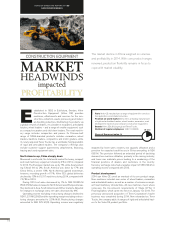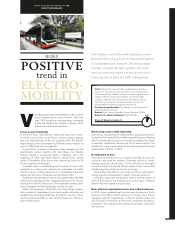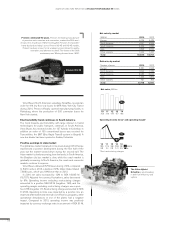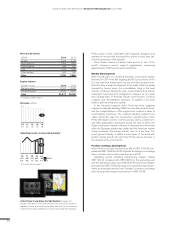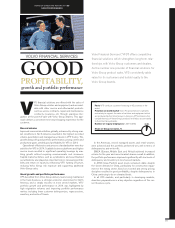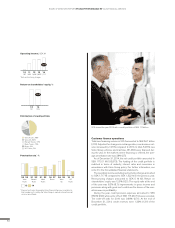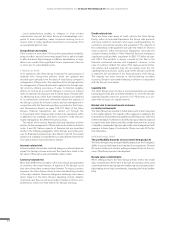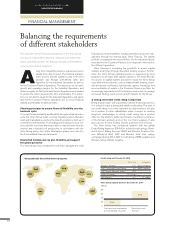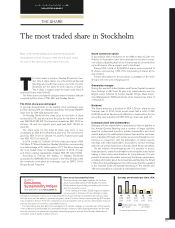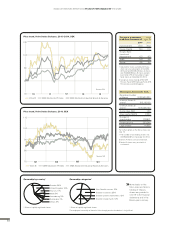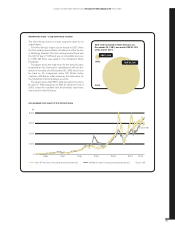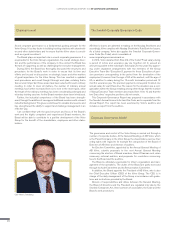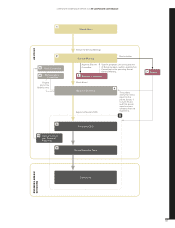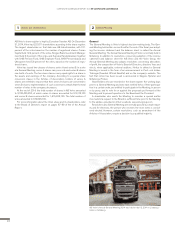Volvo 2014 Annual Report Download - page 88
Download and view the complete annual report
Please find page 88 of the 2014 Volvo annual report below. You can navigate through the pages in the report by either clicking on the pages listed below, or by using the keyword search tool below to find specific information within the annual report.
BOARD OF DIRECTORS’ REPORT 2014 GROUP PERFORMANCE RISKS AND UNCERTAINTIES
Credit-related risk
There are three main areas of credit risks for the Volvo Group.
Firstly, within its Industrial Operations the Group sells products
with open credits to customers and issues credit guarantees for
customers’ commercial vehicles and equipment. The majority of
the outstanding credit guarantees at year-end relates to Chinese
retail customers within Construction Equipment. Secondly, the
customer fi nance activity in Volvo Financial Services manages a
signifi cant credit portfolio, equivalent to SEK 117 billion at year-
end 2014. The portfolio is largely secured by the title to the
fi nanced commercial vehicles and equipment. However, in the
case of customer default, the value of the repossessed commer-
cial vehicles and equipment may not necessarily cover the out-
standing fi nanced amount. Lastly, a part of the Group’s credit risk
is related to the investment of the fi nancial assets of the Group.
The majority has been invested in interest-bearing securities
issued by Swedish real estate fi nancing institutions or deposited
with the Group’s core banks.
Liquidity risk
The Volvo Group strives to have a sound preparedness by always
having liquid funds and committed facilities to cover the Group’s
expected liquidity needs for a period of 12–18 months in a sce-
nario with no access to capital markets.
Market risk from investments in shares
or similar instruments
The Volvo Group has invested in listed shares with a direct exposure
to the capital markets. The majority of this exposure is relating to the
investments in Eicher Motors Ltd and Deutz AG. Please see note 5 for
further information. Furthermore, the Volvo Group is indirectly exposed
to market risks from shares and other similar instruments as a result
of capital in independent pension plans with asset management with
exposure to these types of instruments. Please see note 20 for fur-
ther information.
OPERATIONAL RISK
The profi tability depends on successful new products
The Volvo Group’s long-term profi tability depends on the Company’s
ability to successfully launch and market its new products. Product
life cycles continue to shorten, putting increased focus on the suc-
cess of the Group’s product development.
Resale value commitments
When selling products the Volvo Group at times enters into resale
value commitments. At the time of the sale the evolution of the used
commercial vehicle and equipment market may be uncertain, poten-
tially leading to too high commitments, impacting the future profi ta-
bility.
Local protectionism leading to changes to local content
requirements can put the Volvo Group at a disadvantage com-
pared to local competitors, cause increased sourcing costs or
require Volvo to make signifi cant investment not necessary from
an operational point of view.
Geopolitical uncertainty
Volvo is active in more than 190 countries and political instability,
armed confl icts and civil unrest may impact Volvo’s ability to trade
in affected areas. Rapid change in infl ation, devaluations or regu-
lations can sustain Volvo signifi cant losses, impairment of assets
or costs due to underutilized assets.
FINANCIAL RISK
In its operations, the Volvo Group is exposed to various types of
fi nancial risks. Group-wide policies, which are updated and
decided upon annually, form the basis of each Group company’s
management of these risks. The objectives of the Group’s policies
for management of fi nancial risks are to optimize the Group’s cap-
ital costs by utilizing economies of scale, to minimize negative
effects on income as a result of changes in currency or interest
rates, to optimize risk exposure and to clarify areas of responsibil-
ity. Monitoring and control that established policies are adhered
to is continuously conducted. Information about key aspects of
the Group’s system for internal controls and risk management in
conjunction with the fi nancial reporting is provided in the Corpo-
rate Governance Report on page 106–107. Most of the Volvo
Group’s fi nancial transactions are carried out through the
in-house bank, Volvo Treasury, that conducts its operations within
established risk mandates and limits. Customer credit risks are
mainly managed by the different business areas.
The nature of the various fi nancial risks and objectives and the
policies for the management of these risks are described in detail in
notes 4 and 30. Various aspects of fi nancial risk are described
briefl y in the following paragraphs. Volvo Group’s accounting poli-
cies for fi nancial in struments are described in note 30. The overall
impact on a company’s competitiveness is also affected however by
how various macro -economic factors interact.
Interest-related risk
Interest-related risk includes risks that changes in interest rates will
impact the Group’s income and cash fl ow (cash-fl ow risks) or the
fair value of fi nancial assets and liabilities (price risks).
Currency-related risk
More than 90% of the net sales of the Volvo Group are generated
in countries other than Sweden. A majority of the Group’s costs
also stems from other countries than Sweden. To reduce currency
exposure, the Volvo Group strives to have manufacturing located
in the major markets. However, changes in exchange rates have a
direct impact on the Volvo Group’s operating income, balance
sheet and cash fl ow, as well as an indirect impact on Volvo’s com-
petitiveness, which over time affects the Group’s earnings.
84


